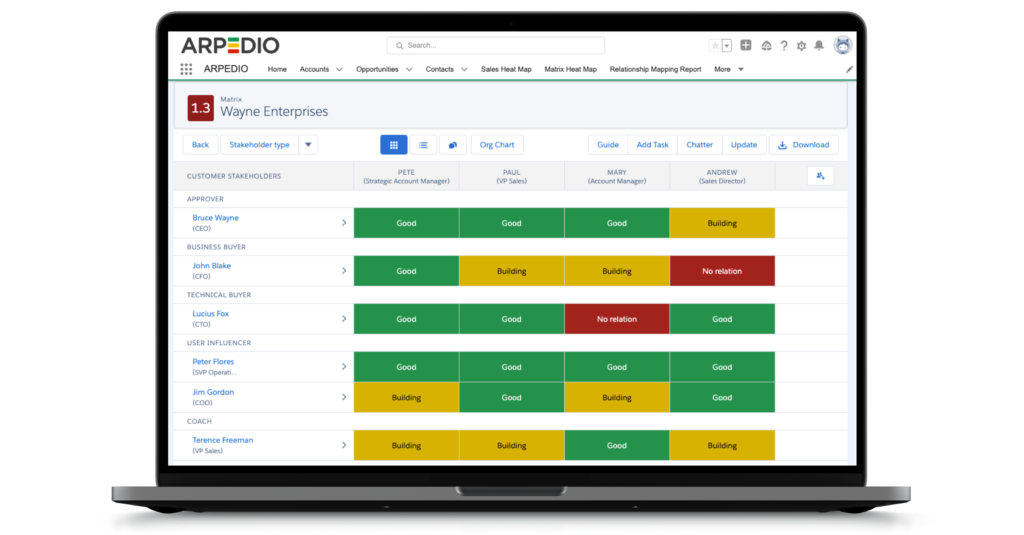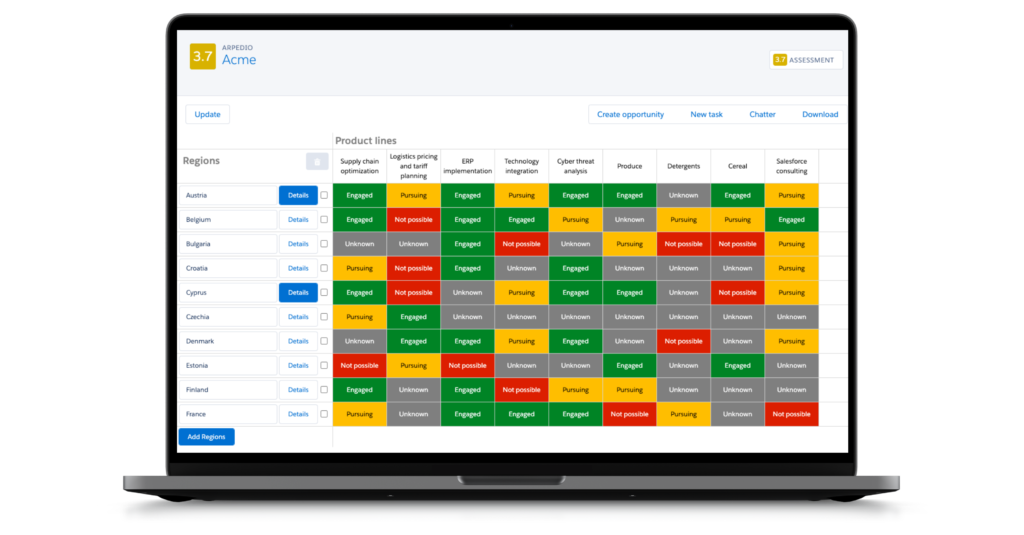For key or strategic accounts, does it matter if marketing works with sales? Absolutely yes! Account-based marketing (ABM) revolutionized marketing. So, why do so many strategic/key account management (SAM/KAM) programs not integrate with account-based marketing? In this LinkedIn Live, we dive headfirst into account-based marketing and why it’s absolutely critical to the SAM journey.
We cover how and why account-based marketing and KAM/SAM integration improves results, the common blockers preventing sales/marketing collaboration, best practices and tactics for increasing pipeline and sales velocity, and finally some first steps to enact account-based marketing and KAM/SAM integration.
Our panelists, Dominique Côté and Angus Robertson, share a great passion for account-based marketing and will spill their wisdom and expertise on the subject, and finally give their best advice on how we bridge the gap between marketing and sales.
Key takeaways
- Account-based marketing should be customer-led and team-enabled
- Sales and marketing need to co-orchestrate the account plan
- Mapping out the customer journey is absolutely crucial
- Account-based marketing starts with a mindset change and management needs to support this cultural shift
A brief introduction to the panelists
Dominique Côté is the CEO and Founder of Cosawi Consulting. She has more than 30 years of experience leading commercial teams in global pharmaceutical and biotech organizations as a Chief Commercial and Marketing officer. Her consultancy work is primarily focused on customer centricity, SAM journeys and account-based marketing, and this way helping organizations with their business transformation, sharing her learning and passion. Dominique is on the board of Strategic Account Management Association (SAMA), and leads the SAMA account-based marketing Academy.
Angus Robertson is a Partner and Chief Marketing Officer at Chief Outsiders, a Management Consulting firm of CMOs. Angus is also currently the fractional CMO at ARPEDIO. Angus has worked in marketing and technology for the past 20+ years and counting, and he has experience from roles in both sales and marketing, business development, and M&A. Angus specializes in the B2B SaaS arena, and he’s very passionate about the world of account-based marketing, and how sales and marketing can work together.
(Re)Defining account-based marketing
There’s no getting around that marketing today is digital. The era of traditional marketing is over, and we have to evolve the way we look at marketing in general, and especially account-based marketing.
There are many ways account-based marketing is defined. Some consider account-based marketing to be marketing campaigns focused on products, personas, or even brand awareness, and some consider account-based marketing specialized marketing tech. However, Dominique argues that account-based marketing is more than these tactics. Account-based marketing is customer-led and team enabled. Account-based marketing is not about the function, it’s about the customer and their journey with us. Often, companies focus on omnichannel activation and demand-gen execution, but, before jumping into the tactics, there’s a lot of upstream work that should be done:
So even though the operationalization is of course critical, as well as targeted marketing, it’s important to remember that marketing is not targeted until it’s integrated with the customer focal points and the customer decision-making and buying journey. Dominique strongly suggests that marketers join sales at the ignition point during the account planning process: “It’s about time that account-based marketing or marketers come to the table and be part of that business discussion.” Marketers have the opportunity to really co-orchestrate the account plan strategies and portfolio of opportunity by leading the customer journey and insight generation.
Why account-based marketing is crucial to the SAM journey
In the world we live in, we can’t afford silo-thinking. To create agility, speed and a competitive edge, it’s inevitable that companies show up as a whole to their customers and accounts. “With our definition of account-based marketing, marketing plays an even broader role, i.e. from ‘just’ being at the account table to actually becoming part of the account team. Because SAM is a team sport, and it takes a village to make a significant difference”, Dominique says.
Still today, our marketing efforts tend to be inside-out focused, i.e., pushing products out to customers and hoping our campaigns align with their needs. Instead we need to flip our perspective and start with what customers want. A customer-led and team-enabled approach must be embraced throughout the customer journey, and account-based marketing can be a catalyst to align customer needs, focal points and touchpoints to be outside-in versus inside-out.
What account-based marketing can bring to the account plan
- The translation of the market research along with the data that comes from it into actionable insights that are relevant to the customer.
- Supporting the SAMs differentiate themselves in bringing relevant insights.
- The ability to bring the account team the corporate value enablers – on top of product and campaign. Because the marketing team is internal, they know what’s going on, bringing corporate values that can be very relevant to the customer.
- Developing the point of communication throughout the customer journey to optimize and scale the opportunities as well as the business case creation.
Thus, beyond product, campaign or any other marketing discipline, account-based marketing embraces all of them and plays a much broader role, and that’s what defines account-based marketing today. Taking the account-based marketing approach to marketing will allow companies to differentiate their offerings by personalizing the value to the customer, as well as supporting the account portfolio opportunities.
To summarize, sales and marketing need to co-orchestrate the account plan. They need to be joined at the hip to, first and foremost, be able to help customers achieve their goals, but also to gain the crucial mindshare, and thus grow the corporate revenue as well.
Blockers preventing Sales and Marketing collaboration
Even though account-based marketing was first introduced back in the early 2000s, it’s taken quite some time to get everyone on board. We still have organizational silos, which can create friction in terms of understanding what a customer journey is, let alone how marketing can actually help optimize the work of strategic account management by mapping out the customer decision-making journey.
Also, fear, tension, and a lack of comprehension of how sales and marketing can benefit from one another has become a barrier for the two working together. The best way to accommodate this challenge and make them realize the value of an integrated collaboration is simply to bring people together. In addition, an outdated mindset and misalignment – both internally and externally – are common blockers for sales and marketing not collaborating more.
From traditional marketing to targeted marketing – shifting our mindset
To a large extent, we’re very good at training SAMs to be outside-in focused in their approach to customers, meaning always being customer-centric and attentive to customer needs. However, even though marketing strives to do the same, a lot of the time, it seems that marketers tend to be more stuck on the traditional inside-out approach. Marketing will start with the product in mind, and then try to align with the customers’ needs, oftentimes resulting in missed value opportunities. That’s why, according to Dominique, the general mindset of marketing needs to shift to a more outside-in, customer-centric approach.
Lack of alignment
The lack of internal alignment in our siloed organizations is another reason why sales and marketing don’t collaborate more. We all have different ways of working, and when the process and the tools are not integrated from a customer perspective or account planning process, it’s hard to reconcile and leverage the expertise and the diversity of having the two groups working together. With a cross-functional team at the table that is not aligned internally it’s much harder to bring relevance to the key customers as well as actually make an impact.
In terms of external alignment, Dominique emphasizes that it’s absolutely critical to understand and map out the customer decision-making journey, all the way from the point of inspiration to the point of decision. This is vital for our knowledge and understanding of customer needs as well as the ability to leverage external data for targeted marketing relative to those customer needs: “When it’s not targeted to the customer’s needs, it’s not integrated, and thus it’s not really targeted”, Dominique says.
Mapping out your customer journey
Angus completely agrees that mapping out the customer journey is essential. He finds, more often than not, that organizations don’t effectively map out the customer journey, and this, for starters, is a real challenge. If the customer journey hasn’t been mapped out, then the collaboration across departments will suffer greatly:
If different business units don’t work together, it can prove very difficult for customers to understand your experience, and what that one voice is from you as a vendor. Different departments within an organization tend to look at themselves as individual entities with different priorities, but from a customer point of view, they’re looking at your company as a whole. Therefore, it’s crucial that you present yourself as one unified entity, and ensure that you’re providing value and a positive experience across all the different departments.
Angus stresses that the last thing you want is a salesperson working on a key deal, and at the same time Finance is chasing down a bill that hasn’t been paid with nasty collections notices. In parallel, there’s a support escalation that you know is going sideways. If these three departments don’t know what’s happening, then at the end of the day, that customer experience is not going be good.
Bottom line, Angus says, not paying attention to the customer journey will impact the health of both the customer and you as a vendor. Therefore, mapping out the customer journey is an inevitable prerequisite for effective account-based marketing and key account management.
Best recommendations to integrate SAM and account-based marketing
Account management is a journey, a business transformation if you will, and it requires a cultural shift. Dominique shares that she’s often asked ‘if we need to forget about product, campaign, and enterprise marketing?’ No, that’s not the case, but to start this journey, the utmost priority is to start with the customer needs, have marketing join the account table and co-orchestrate the account plan – this is where the customer journey mapping and aligning begins. Marketing can optimize the SAM work in bringing targeted insight throughout the point of communication along the customer journey.
Marketing should be the ‘connector’ between sales and (potential) customers as they are the expert on value enablers beyond product(s) and service(s). Marketing can then connect and align with the product and brand and everything else, but they can also bring so much more to the table in a much broader sense, e.g., take part in creating the value proposition personalized to the account plan opportunity, and bridging between product and campaign marketing and the account planning work.
Where account-based marketing leads the differentiated message and point of communication throughout the customer journey, the SAMs lead the portfolio creation of opportunity, and through this collaboration they can really create a team-enabled account team, and provide more value to the organization. Again, it’s about co-orchestrating.
Angus agrees that it can be incredibly valuable to include marketing and let them help with the messaging to add an extra layer based on sales’ existing understanding of the accounts: “The last thing you want a salesperson doing is providing a generic answer.” So whatever marketing can do to empower the salesperson based on the circumstances he or she has already discovered within the account to provide a very targeted and relevant message, that will inevitably have a positive impact all around: it will help their credibility, the relationship with the account, and develop more business at the account. “It’s all towards that end goal of supporting the business conversation and presenting value in that business conversation”, Angus says.
A great way to start co-orchestrating between marketing and sales is with the element within account-based marketing called Programmatic Display Ads, Angus says. This way marketing can go to sales and say: ‘we’ve got this powerful tool where we can reach your audience in ways that you can’t reach them. So help us understand what your key accounts are, what the dynamics are within those key accounts, and what those care abouts are’. Then marketing can put together a list straight from the CRM, load it into the account-based marketing platform, and target those accounts with custom messaging, depending on where the prospect is within the sales cycle.
In Angus’ opinion, this is a great first – and very defined – step that can help sales and marketing work together, and a step for marketing to prove that they can provide actual value to sales. And subsequently, encourage sales to start thinking about other ways that they can work with marketing to leverage their resources and their budget to support their development of key accounts. “I always find the best salespeople are the ones that get the organization to work for them, and this is an example of that”, Angus says.
Dominique adds that to be able to leverage off this sales and marketing collaboration, it’s absolutely crucial that the executive team supports this cultural shift. Bringing everyone together at the account table as one unified organization and thus creating a role for account-based marketing needs to be backed at C-level, ensuring that the leadership is actively supporting the cultural shift. Therefore, Dominique stresses that our mindset really needs to change to embrace this cultural shift:
Thus, account-based marketing is a key component in leveraging that digital transformation, to optimize pipeline, and to be able to provide the targeted value. Angus completely agrees: “If you don’t have the understanding at the executive level of what that collaboration will bring, and the outcome they’re driving towards, and supporting that culture shift, then you’re not going to get very far.”
The evolving sales enablement tech stack
We know that account-based marketing within many organizations has been a key go-to-market tactic, and for the ones that adopted it early, it was a way for them to differentiate and deliver their unique value proposition to customers and thus achieve a competitive advantage.
Sales are now getting access to some powerful new sales enablement tools, and this all started with the CRM. In this regard, especially Salesforce stands out in developing the capabilities of the CRM with their ecosystem of applications, their network of ISVs, as well as system integrators globally. Today, Salesforce has more than 150,000 customers worldwide. Besides the CRM capabilities, there are now a plethora of additional sales enablement tools.
As we’ve established, there’s account-based marketing. Also, in the realm of sales enablement are categories that include the B2B data providers which enhance your CRM data and better target your audience. Then there’s the reporting tools for better visualizations from a timing perspective, as well as the ability to accurately calculate sales velocity. Then there’s the appointment setting category. This is commonly used for sales/business development, providing automation for email and phone cadences.
Last but not least, Angus mentions account-based selling as a new important player in the field. The Tier 1 analysts are starting to talk about key account management, strategic account management, or account-based selling as a (new) sales enablement category, so within the broad rubric of sales enablement, we now have Account-Based Selling too.
Account-based selling (ABS)
Taking advantage of these sales enablement software like account-based marketing and account-based selling, Angus foresees, we will start to programmatically or systematically capture the data from the sales team relative to the organization’s best practices, and then we can start to combine them with the other sales productivity tools.
Being able to combine the information from account-based marketing, i.e. the industry specific or account specific messaging, as well as some intent data to understand if an account is actually looking for something or not, with that sales landscape is an absolute game-changer, Angus says:
All in all, it’s a very exciting time for sales, Angus finishes, and he is positive that sales leaders, key account managers, and strategic account managers that start to take advantage of this technology will gain an edge.
At ARPEDIO, all of this is very interesting because being able to look at relationships, accounts, opportunities, white space, and do assessments that are standardized based on best practices within the sales organization, i.e., what makes a good opportunity? What determines the health of an account? And being able to visually represent that through a heat map, determining the health of the pipeline or of the accounts is exactly what ARPEDIO caters to.
Watch or re-watch our LinkedIn Live on account-based marketing and account-based selling below:

Maximilian Opp, Head of Sales International
+45 53 50 78 33
max@arpedio.com
linkedin.com/in/maximilian-opp/
Follow us on LinkedIn to get all the newest perspectives and insights around strategic relationship management and sales innovation.

Maximilian Opp, Head of Sales International
+45 53 50 78 33
max@arpedio.com
linkedin.com/in/maximilian-opp/
Follow us on LinkedIn to get all the newest perspectives and insights around strategic relationship management and sales innovation.
#1 Account-Based Selling Platform
Powerful alone. Superior together.
Boost win rates and reduce sales cycles. Enhance forecast accuracy.









